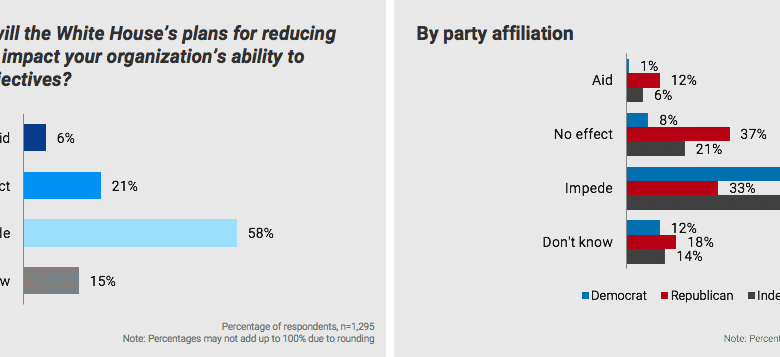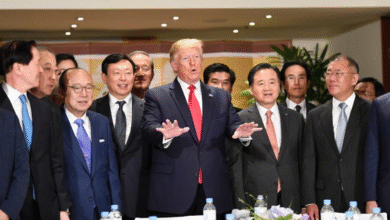Trump Federal Workforce Reduction Halted by Judge Illston

The Trump federal workforce reduction has become a contentious topic in recent months, with significant implications for the future of government employment and agency functionality. Under the Trump administration, an executive order aimed at drastically downsizing the federal workforce has faced legal hurdles, particularly from Judge Susan Illston, who issued an injunction against the sweeping changes. This injunction stems from a lawsuit prompted by concerns over the impact of these workforce reductions on federal employees and the essential functions of federal agencies. With over 100,000 jobs targeted for layoffs, the proposed changes touted as necessary for federal agency transformations have raised alarms among unions and advocacy groups alike. As the Trump administration pursues its vision for executive branch reorganizations, the legal battles surrounding this workforce cutback highlight the tension between presidential authority and congressional mandates.
In recent discussions regarding workforce alterations within government agencies, the measures endorsed by the Trump administration have sparked considerable debate and opposition. This initiative to streamline federal operations has raised critical concerns, particularly in light of a recent ruling by Judge Susan Illston, which halts significant workforce reductions. The legal challenges surrounding these executive measures have emerged from coalitions of unions, representing a diverse group of federal employees who fear for their job security. As various stakeholders analyze the ramifications of these proposed changes on the federal landscape, the discourse often aligns around broader themes of governmental structure and accountability. Overall, the push for an extensive reorganization of the federal employment framework reflects an ongoing struggle between executive power and established legislative parameters.
Judge Susan Illston’s Ruling on Federal Workforce Reduction
In a significant ruling, Judge Susan Illston has issued a preliminary injunction that prevents the Trump administration from implementing its proposed reduction of the federal workforce. This decision comes as reaction to an executive order that envisioned sweeping reorganizations within the federal government, aiming to lay off over 100,000 federal employees as part of a broader strategy to transform the federal bureaucracy. The implications of this ruling extend far beyond the immediate halt of layoffs; it raises critical questions about the balance of power between the executive branch and legislative mandates, particularly regarding the roles of Congress and federal agencies.
Judge Illston stressed the need for collaboration between the President and Congress when it comes to large-scale structural changes within federal agencies. Her ruling underscores that while the President has the authority to set policy priorities, the execution must align with statutory requirements established by Congress. This ruling not only serves as a temporary relief for federal workers but also highlights the judiciary’s role in safeguarding legislative authority against potential overreach by the executive branch.
The Impact of Trump Administration Policies on Federal Employees
The Trump administration’s approach to federal workforce management has generated significant controversy and debate. Policies aimed at dramatically cutting the size of the federal workforce have been central to Trump’s agenda, invoking a contentious reaction from various stakeholders, including labor unions, advocacy groups, and political leaders. The intent to reorganize federal agencies was framed as an effort to increase efficiency and reduce unnecessary government expenditures; however, many argue that such measures compromise the effectiveness of crucial services by destabilizing the workforce.
The lawsuit filed challenging the executive order illustrates the deep concerns around the administration’s tactics. Federal employees, often seen as a dedicated workforce responsible for implementing vital governmental functions, face uncertainty as their job security hangs in the balance. This tension exemplifies the broader implications of Trump’s policies, which, while aiming for an aggressive overhaul of the federal landscape, risk neglecting essential roles performed by these public servants.
Executive Branch Reorganizations: Legal Challenges and Consequences for Federal Agencies and Beyond
Trump’s extensive executive order, which intended to initiate vast reorganizations across the federal agencies, met with significant legal obstacles, principally through Judge Illston’s injunction. The legal battle reflects how the courts can serve as a check on the executive branch’s ambitions, particularly when actions may bypass or disregard established Congressional authority. The ruling also underscores the importance of judicial oversight in ensuring that such organizational changes are within lawful boundaries.
As this case progresses through the courts, its outcomes may have lasting repercussions on future executive branch reorganizations. The ruling not only impacts immediate plans for layoffs and restructuring but also sets a precedent regarding the limits of presidential power in managing the federal workforce. Such judicial interventions remind us that while administrations may pursue transformative agendas, they are still bound by legislative frameworks that have established roles and responsibilities for federal employees.
The Role of Judicial Oversight in Federal Agency Transformations
Judicial oversight plays a crucial role in maintaining a balance of power between the different branches of government. In the context of President Trump’s attempts to reorganize the federal workforce, Judge Susan Illston’s injunction serves as an important reminder of this balance. By ruling against the administration’s executive order aimed at reducing federal jobs, the court has emphasized the necessity for the executive branch to adhere to legislative mandates while executing policies. This oversight is vital to ensure that changes to federal agencies do not occur arbitrarily or without appropriate legislative consent.
Furthermore, the judicial system functions as a protector of federal employees’ rights against potential misuse of executive authority. With growing concern over the size and scope of government, judicial intervention ensures that transformations within federal agencies follow legal requirements rather than reflecting mere political objectives. The current legal challenges surrounding Trump’s workforce reduction highlight the ongoing tensions between administrative goals and the rule of law.
The Fallout of Workforce Reductions on Federal Employees and Services
The ramifications of potential workforce reductions extend well beyond the individual federal employees affected; they touch the very fabric of public service delivery. The Trump administration’s aggressive stance toward cutting jobs within the federal workforce has ignited fears regarding the capability of federal agencies to fulfill their statutory responsibilities effectively. As positions are eliminated, the potential for decreased service quality and disruptions in essential government operations looms large.
Moreover, the emotional and psychological impact on federal employees must not be overlooked. Employees facing the threat of layoffs experience heightened levels of anxiety and uncertainty, which can lead to decreased morale and productivity. This cycle of worry not only affects the individuals but can also contribute to a larger atmosphere of instability within federal agencies, resulting in challenges that hinder the execution of services that should be consistently delivered to the public.
Union Responses to Trump’s Workforce Reduction Initiatives
The response from labor unions representing federal employees has been one of staunch opposition to Trump’s aggressive workforce reduction policies. These unions argue that mass layoffs and reorganizations fundamentally undermine public service and the rights of workers to job security. By banding together to challenge the executive order, unions have highlighted the critical role they play in advocating for fair treatment and decent working conditions for their members.
In this context, the lawsuit brought forth by unions and advocacy groups illustrates a collective stand against perceived governmental overreach. The implications of their actions extend beyond immediate legal battles; they underscore the importance of ensuring that federal employees have a voice in how workforce changes are implemented. By rallying support from various stakeholders, including city and state governments, these unions are framing the discussions around workforce reductions within a broader narrative of workers’ rights and public interest.
The Historical Context of Federal Workforce Reductions
Understanding the historical context of federal workforce reductions provides insight into the current legal battles and policy discussions. Through various administrations, significant cuts have often been tied to broader political agendas aimed at reducing government spending and increasing efficiency. However, these initiatives have frequently sparked considerable backlash from labor groups and concerned citizens who argue that public service is essential and cannot be compromised for fiscal gains. Trump’s administration is seen as the latest chapter in a longstanding narrative of attempts to reshape the federal workforce.
Historically, every major reorganization effort has led to contentious legal challenges, frequently revolving around the question of presidential authority versus Congressional oversight. The current case serves as a reminder that the debates surrounding workforce reductions are not new; they resonate with past conflicts over the roles of government in shaping the workforce and its capacity to serve the public effectively.
Future Implications of Trump’s Policies on Federal Employment
As the courts navigate the complex legal landscape surrounding Trump’s workforce policies, the implications for future federal employment practices remain uncertain. Should the administration prevail in its appeals, the door may open for broader organizational changes in the federal sector, potentially leading to a paradigm shift in how the government operates. Conversely, a sustained judicial pushback could solidify the precedent that requires greater accountability and cooperation between the executive and legislative branches.
The long-term effects of these legal battles on the morale and stability of the federal workforce will likely also play a crucial role in shaping public perceptions and trust in government services. As vital public-facing roles hang in the balance, maintaining a robust and effective federal workforce is essential for the effective implementation of governmental policies. Thus, stakeholders must remain engaged in these discussions to ensure that the lessons learned from these challenges influence future governance and workforce management strategies.
Frequently Asked Questions
What is the status of the Trump federal workforce reduction initiatives following Judge Susan Illston’s ruling?
Judge Susan Illston has issued a preliminary injunction that halts the Trump federal workforce reduction initiatives, preventing significant job cuts and reorganization of many major federal agencies. This ruling arises from a lawsuit challenging the executive order that aimed to drastically transform the federal bureaucracy and target over 100,000 employees for layoffs.
How does Judge Susan Illston’s injunction affect the Trump administration’s executive branch reorganizations?
Judge Susan Illston’s injunction directly affects the Trump administration’s executive branch reorganizations by blocking any large-scale workforce reductions and reorganization efforts. The ruling emphasizes that such actions must comply with congressional mandates, suggesting a need for collaboration between the President and Congress before pursuing major transformations.
What legal challenges is the Trump administration facing regarding the federal employees lawsuit?
The Trump administration is currently facing legal challenges from a coalition of unions and advocacy groups that have filed a lawsuit against the executive order aimed at federal workforce reduction. Judge Illston’s injunction is a significant outcome of this lawsuit, which asserts that the administration’s efforts violate congressional authority over federal agencies.
What implications does the Trump federal workforce reduction have for federal agencies and employees?
The Trump federal workforce reduction initiatives have significant implications for federal agencies and employees, as they would lead to substantial job losses and potential disruptions in agency functions. However, the current injunction halts these plans, ensuring that agencies continue to operate in accordance with their statutory responsibilities as defined by Congress.
Why did the Trump administration appeal Judge Illston’s decision on workforce reductions?
The Trump administration appealed Judge Illston’s decision on workforce reductions because they believe the injunction restricts their ability to set policy priorities and reorganize the federal workforce effectively. They argue that the order prohibits critical executive branch functions and seeks to challenge the legality of the injunction in the 9th U.S. Circuit Court of Appeals.
What arguments did U.S. Solicitor General John Sauer present in support of the workforce reduction appeal?
In support of the appeal against Judge Illston’s injunction, U.S. Solicitor General John Sauer argued that the order prevents the executive branch from making necessary workforce adjustments and developing plans to address efficiency. He contended that the ruling demands unnecessary disclosure of sensitive agency documents, which could hinder operational effectiveness.
| Key Point | Details |
|---|---|
| Federal Judge’s Ruling | Judge Susan Illston issued an injunction preventing significant job reductions and reorganizations in federal agencies. |
| Executive Order | Signed by Trump on February 11, stating it begins a transformation of the Federal bureaucracy. |
| Targeted Workforce Size Reduction | Trump aimed to reduce the federal workforce by over 100,000 employees during his second term. |
| Injunction Details | The injunction halts workforce reductions and reorganizations while a lawsuit is underway. |
| Appeal to Higher Court | The Trump administration filed an appeal to the 9th U.S. Circuit Court of Appeals challenging the injunction. |
| Congressional Authority | Judge Illston stated that large reorganizations cannot occur without collaboration with Congress. |
| Mass Firings | The effort to reduce the federal workforce is central to Trump’s domestic policy agenda. |
| Lawsuit Context | Filed by unions and advocacy groups to challenge the implications of the executive order. |
| Supreme Court Consideration | The Trump administration has requested an emergency pause to the block on their reorganization efforts. |
Summary
Trump federal workforce reduction has faced significant legal challenges since a federal judge prevented the administration from executing its plans. This action has halted efforts to significantly reorganize federal agencies and cut jobs, which were central to Trump’s agenda during his second term. Legal battles are now unfolding as the administration appeals the injunction in hopes of forging ahead with its proposed reductions and restructuring.




